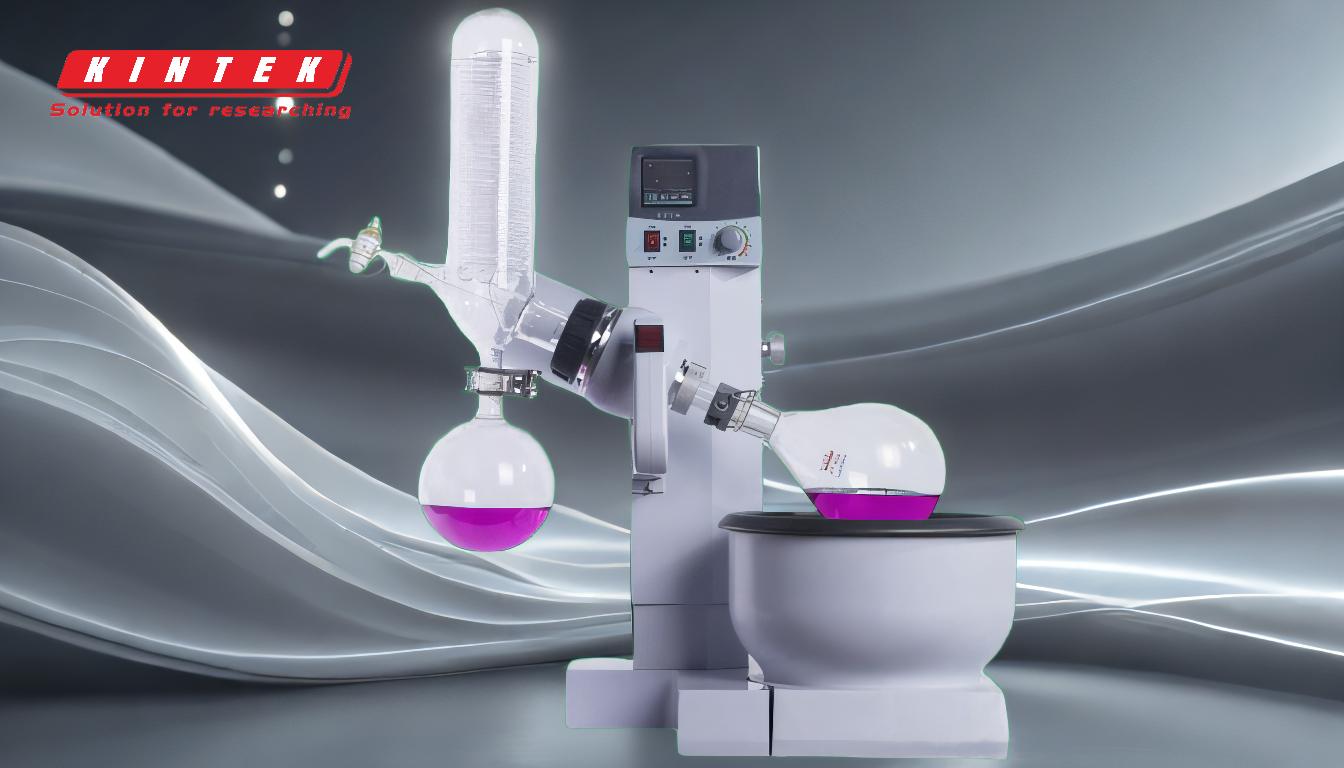In a rotary evaporator (rotovap), the solvent is initially present in the rotating flask, where it is heated and evaporated under reduced pressure. The evaporated solvent then travels through the system, condenses in the condenser, and is collected in a separate receiving flask. This process allows for the efficient separation and recovery of the solvent from the sample, enabling its reuse or disposal. The key components involved in this process include the rotating flask, condenser, vacuum pump, and receiving flask.
Key Points Explained:

-
Initial Location of the Solvent (Rotating Flask):
- The solvent is first introduced into the rotating flask, which is partially submerged in a heated water bath.
- The rotation of the flask increases the surface area of the solvent, promoting faster and more uniform evaporation.
-
Evaporation Under Vacuum:
- A vacuum pump reduces the pressure inside the system, lowering the boiling point of the solvent.
- This allows the solvent to evaporate at a lower temperature, minimizing the risk of thermal degradation of heat-sensitive compounds.
-
Condensation in the Condenser:
- The evaporated solvent vapor travels from the rotating flask to the condenser.
- The condenser, often cooled by a circulating coolant (e.g., cold water or a refrigerant), cools the vapor back into a liquid state.
-
Collection in the Receiving Flask:
- The condensed liquid solvent drips from the condenser into a receiving flask.
- This collected solvent can then be reused in subsequent experiments or disposed of safely, depending on the laboratory's protocols.
-
Separation of Solvent and Desired Compound:
- The solvent is separated from the desired compound, which remains in the rotating flask.
- This separation is crucial for isolating and purifying the target compound without contamination from the solvent.
-
Advantages of Using a Rotovap:
- Efficiency: The rotovap allows for rapid and efficient solvent removal, even for large volumes.
- Gentle Processing: The reduced pressure and controlled heating minimize the risk of damaging sensitive compounds.
- Solvent Recovery: The ability to collect and reuse solvents makes the rotovap an environmentally friendly and cost-effective tool.
-
Applications in Various Fields:
- Chemistry Labs: Commonly used for solvent removal, compound isolation, and purification.
- Molecular Cooking: Utilized to create distillates and extracts with precise flavor profiles.
- Pharmaceuticals: Essential for the extraction and purification of active pharmaceutical ingredients (APIs).
-
Safety Considerations:
- Proper handling of the vacuum pump and condenser is essential to prevent accidents.
- Ensuring that the system is properly sealed and that all components are securely attached minimizes the risk of leaks or spills.
By understanding the journey of the solvent through the rotovap—from the rotating flask, through the condenser, and into the receiving flask—users can optimize their processes for efficient solvent recovery and compound isolation. This knowledge is particularly valuable for equipment and consumable purchasers, as it highlights the importance of selecting high-quality components (e.g., durable condensers, reliable vacuum pumps) to ensure consistent performance and safety in laboratory operations.
Summary Table:
| Key Component | Function |
|---|---|
| Rotating Flask | Holds the solvent, increases surface area for faster evaporation. |
| Vacuum Pump | Reduces pressure to lower the solvent's boiling point. |
| Condenser | Cools vaporized solvent back into liquid form. |
| Receiving Flask | Collects the condensed solvent for reuse or disposal. |
| Advantages | Benefits |
| Efficiency | Rapid solvent removal, even for large volumes. |
| Gentle Processing | Minimizes thermal degradation of sensitive compounds. |
| Solvent Recovery | Environmentally friendly and cost-effective. |
| Applications | Fields |
| Chemistry Labs | Solvent removal, compound isolation, and purification. |
| Molecular Cooking | Creation of distillates and extracts with precise flavors. |
| Pharmaceuticals | Extraction and purification of active pharmaceutical ingredients (APIs). |
Optimize your lab processes with a high-quality rotary evaporator—contact us today for expert guidance!











